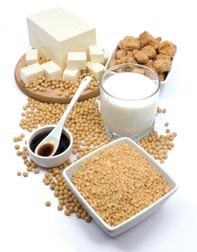Soy and health: the latest evidence
The soybean (Glycine max) has a long history as a domesticated plant, with records of its use as far back as the eleventh century BC in China. Missionaries carried it into Korea and Japan in the third and fourth centuries AD. The soybean is a member of the Leguminosae family of plants that form root nodules while harbouring nitrogen-fixing soil bacteria in a symbiotic association.
Soybeans are very rich in nutritive components. They have a high protein content and appreciable amounts of fibre, calcium, magnesium, phosphorus and potassium. They also contain isoflavones, compounds that have oestrogen-like structures (phytoestrogens). The dominant isoflavone in soy is genistein; daidzein and glycitein are others that are present. Other bioactive components of soybeans include saponins, protease inhibitors and phytic acids. According to the US Department of Agriculture’s National Nutrient Database for Standard Reference, soybean-based foods contain variable amounts of the nutritive components of the beans, including isoflavones.

